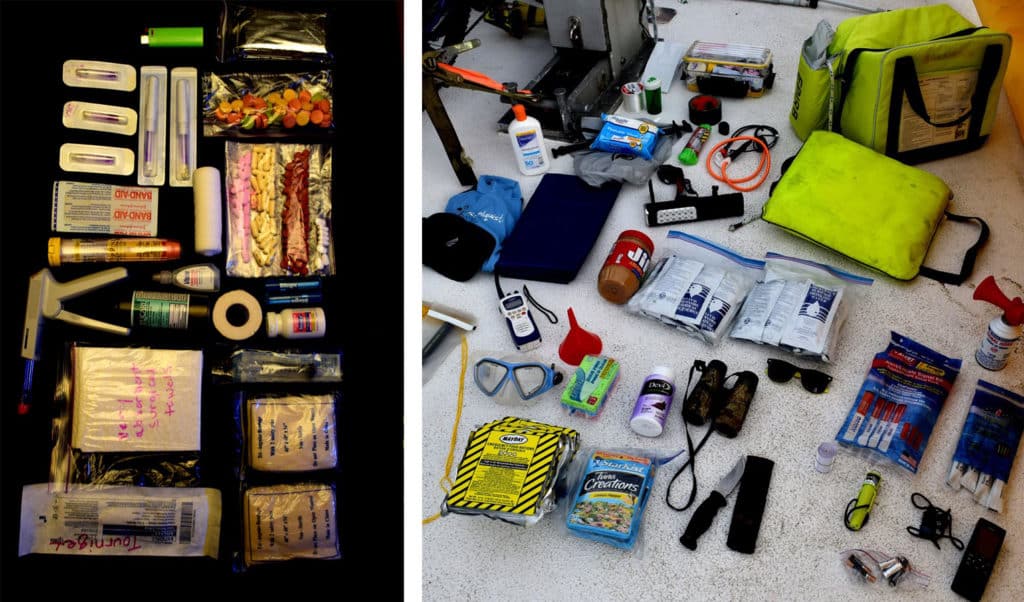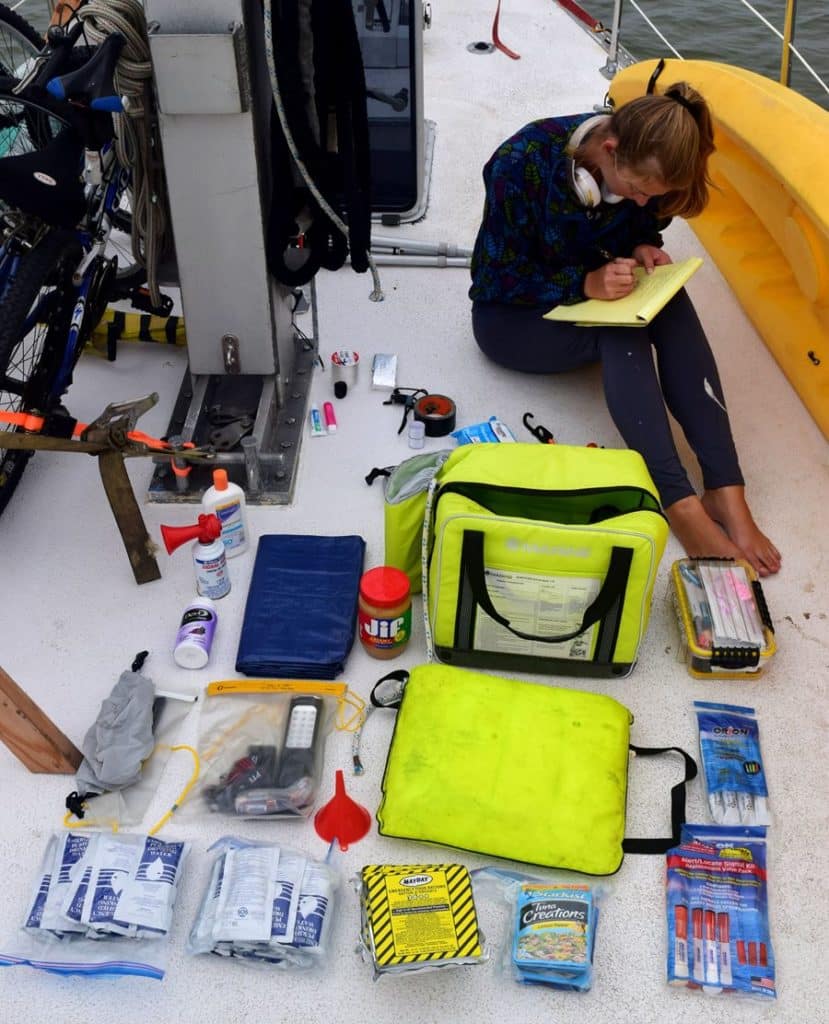
When cruising, safety should always be at the forefront of your mind. Having a well-stocked and meticulously-planned ditch bag can be the difference between surviving to write your best-selling account or taking an extended trip to Davey Jones’ locker. Most of the items needed can be grabbed from home at little to no expense. The more pivotal items are worth spending a bit of money on.
There are three phases of preparing your ditch bag: stocking, packing, and stowing your bag. This is the list I used to prepare for a four-person crew circumnavigating the world in a tropical climate. It’s a good foundation for preparing your own bag for your specific circumstances.
Stocking the Bag
I found it helpful to break things down into categories. Our bag is broken into five groups: medical, nutrition and hydration, signaling and navigation, tools, and personal. Below is a complete list of what we keep in our Ultimate Survivor Technologies Marine Survivor Ditchbag 1.0.
Packing
Once you’ve found what you need for your ditch bag, take care in how you pack it. In the event of an abandon ship, it’s likely things will be hectic, people may be injured, and the seas will probably be rough. Packing your bag accordingly – so necessities are easily accessible – will make a big difference.
First, make sure your throwable is near the ditch bag with 40 feet of solid bowline pre-attached. Make sure knots are pre-tied and inspected by another crew member. If you do need to abandon ship, you’ll need to pull in anyone who’s in the water – having lines and knots ready ahead of time will save time (and possibly lives).
In an emergency, you’ll also want light so you can see what you’re doing and assess the situation. Headlamps, light sticks, and waterproof flashlights should be near the top of your bag, followed by emergency blankets and medical supplies to tend any injuries that need immediate attention. Once everyone is in the life boat and as stable as possible, the next priority is rescue. Under the medical supplies are the EPIRB, flares, GPS, and handheld radio.
After those basics have been packed near the top or attached to the outside of the bag, it’s up to you to decide how to use the remaining space. Most of the other equipment isn’t vital within the first moments of abandoning ship, so you can fill the bag according to your needs.
Another helpful tip when packing your gear is to organize things in groups and store them in clearly-labeled waterproof bags. Whenever possible, fill the bags with as much air as you can. Even though it takes up space, it will help your bag float if it doesn’t make it into your lifeboat. (I’ve also read of other sailors who cut up pool noodles and stuff them into nooks and crannies to make their bags more buoyant.)
Proper Storage
Once your bag is properly stocked and packed, the last step is to store it. Space on a boat is precious. The least-used items are usually squired away in a bilge or abandoned in an extra birth. It’s tempting to do the same with your ditch bag – don’t! The best place for a ditch bag is somewhere on deck that’s easily accessible and near your lifeboat. You don’t want to be down below wading through three feet of water to get your emergency supplies.
On our boat, we keep the ditch bag and one of our two lifeboats in a storage bench below the driver’s seat. Right next to that, strapped to the deck, is our full jerry jug of fresh water. It’s a great spot for our gear: it’s waterproof (protecting the contents inside), it’s easily accessible, and it provides enough room to keep all of our ditch gear together. It’s close to the radios, controls, and emergency signaling gear so we can send mayday calls as long as possible, and it’s one of the highest spots, giving us enough time to properly deploy the raft and gather as many supplies as we can before stepping onto the lifeboats.
No sailor wants to think about a situation where he/she might need a ditch bag, but taking time before your trip to plan, organize, and stow your bag properly can make a life-or-death difference. Plan ahead so you and your crew can sail confidently, knowing that you’re prepared for the best – and worst – case scenarios.

Sample Packing List:
Medical
- Splint
- Skin stapler with staples
- Tourniquet
- Triangular and assorted bandages
- Dermabond – one at .5 ml, two at .36 ml, and two at .7 ml
- Anti-diarrhea pills – Bismuth Subsalicylate
- Painkiller – Norco
- Anti-inflammatory – Ibuprofen
- Antibiotics – Amoxicillin and Azithromycin: We keep two antibiotics because two of our crew members have antibiotic allergies. The packages are clearly labeled with their names to avoid confusion.
- Antihistamine – Benadryl
- Medical tape
- Syringe
- Antiseptic solution – Povidone Iodine: Iodine can also be used to disinfect fresh water, in addition to its medical uses.
- EpiPen
- Gauze
- Surgical towels
- Mylar emergency blanket
- Visine
- Personal medication
Nutrition and Hydration
- Vitamin C tablets – 50
- Tuna fish pouches – 10
- Mayday Emergency Food Rations 3600 – four
- Peanut butter – 40 oz.
- Dex 4 glucose tablets – 50
- Drinking water pouches – Twenty-three 4.2 fl. oz. pouches: These drinking water pouches are pre-rationed and provide the precise amount of fresh water needed to sustain life. They are not to be used unless all other means of collecting fresh water have been exhausted.
- Jerry jug – five gallons drinking water: The jerry jug is not actually in the ditch bag, but is always full and on-deck near the bag.
- Solar still
Navigation and Signaling
- Whistle
- ACR C-Strobe Light
- 3M High Reflective Tape – 50 ft.
- Orion light sticks – one white (8-hours), two green (12-hours), one red (12-hours)
- Handheld flares – three: Always be sure that your flares are current (they usually have a shelf life of about three years). The expiration date can be found on the packaging.
- 12-gauge aerial flares – three
- Smoke flare
- Signal horn
- Garmin GPS 12
- West Marine Handheld VHF Radio: We use a battery pack that runs on AA batteries instead of rechargeable batteries.
- Signaling mirror
- Compass
- Paper and pens
- ResQlink+ Personal Location Beacons – four: Also not in the ditch bag are our ResQlink+ PLBs, which are attached to our life jackets. It is assumed that, in an emergency situation, each crew member would be wearing their life jackets.
- Emergency Position Indicating Radio Beacon (EPIRB)
Tools
- Fishing kit – 280 yards of 50 lb. line, sinkers, hooks, jig heads, and artificial minnow Rapalla lure
- Velcro
- Duct tape
- Various bungee cords
- Nylon para cord – 50 ft.
- Throwable floatation device with 40 ft. of throwing line
- Stainless carabiner
- Four dry bags for storing ditch-bag contents
- One dry box
- Lighter
- Funnel
- Tarp
- Goal Zero Lantern – waterproof, solar or hand crank
- Headlamp
- Batteries – eight AA and four AAA
- Knife with sheath
- Cutting board
- Air pump
- Raft repair kit
- Binoculars
- Goggles
- Watch
Personal
- Flushable wipes
- Chapstick – SPF 30
- Sunscreen – SPF 50
- Copies of passports
- Emergency medical forms
- Baseball hats
- Synthetic long sleeve shirt
- Sunglasses
- Deck of cards
- Water shoes
- Prescription eyeglasses
- Complete inventory of ditch bag
- Survival instruction manual








